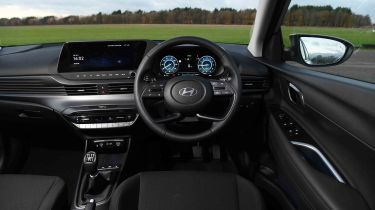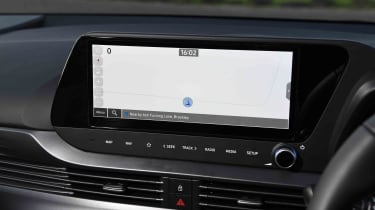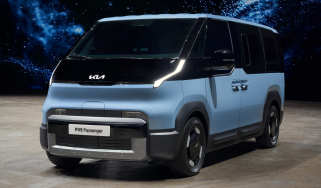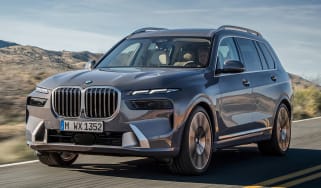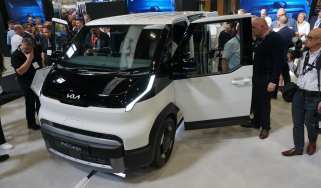Hyundai i20 - Interior, design & technology
Let down by some subpar materials, but the Hyundai i20 is well equipped, and the infotainment is logical to use

If the Hyundai i20 exterior styling is considered wild, then the cabin design is quite conservative in comparison. There’s some visual interest with the unusual four-spoke steering wheel design, vents that seem to flow into the rest of the dashboard, and a 10.25-inch digital instrument display standard to all i20s. However, there’s a depressing lack of colour used – even with the Lucid Lime interior stitching option. It’s nowhere near a Citroen C3 in terms of imagination.
It’s not up to the quality of a Renault Clio, either. There’s a bit of a mishmash of textures and only a thin layer of soft-touch materials on the top of the dashboard and door armrests. To be fair to Hyundai, everything seems well screwed together, with no evidence of squeaks or rattles. Equipment levels are good, and the 64-colour ambient interior lighting that comes with mid-range Premium and above, helps compensate for the lack of visual stimulation with a sprinkling of colour – at least at night.
The entry-level Advance gets cruise control, LED front and rear lights, manual air-conditioning, a rear-view camera, and parking sensors. A 10.25-inch digital cluster is a neat standard feature, too. Like on premium rivals such as the Volkswagen Polo and Audi A1, you get a configurable display to keep track of major functions.
Premium trim adds 17-inch alloys, automatic wipers, a wireless smartphone charging pad, and niceties such as heated seats and a heated steering wheel. The Ultimate brings keyless entry and start, blind spot warning and Bose premium audio.
Sat-nav, stereo and infotainment
Like many rivals, the i20 has an infotainment screen placed high on the dashboard, level with the driver’s instrument cluster. On Advance models, you get an eight-inch screen with useful physical controls on either side of the display, which serve as quick links to the system’s major functions.
Premium and Ultimate trim lines get a larger 10.25-inch display with a row of touch-sensitive quick link ‘buttons’ below the screen. We don’t find this set-up to be as intuitive as the physical buttons surrounding the smaller screen, though we are thankful that the volume knob remains as a physical control. Hyundai’s systems are always logical to use, and the larger screen features built-in navigation, though smartphone users can still connect their device to the screen and use a navigation app instead.
